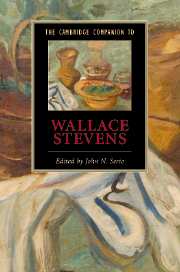Book contents
- Frontmatter
- Introduction
- 1 Wallace Stevens: A Likeness
- 2 Stevens and Harmonium
- 3 Stevens in the 1930s
- 4 Stevens and the supreme fiction
- 5 Stevens’ late poetry
- 6 Stevens and his contemporaries
- 7 Stevens and romanticism
- 8 Stevens and philosophy
- 9 Stevens’ seasonal cycles
- 10 Stevens and the lyric speaker
- 11 Stevens and linguistic structure
- 12 Stevens and painting
- 13 Stevens and the feminine
- 14 Stevens and belief
- Further reading
- Index
4 - Stevens and the supreme fiction
Published online by Cambridge University Press: 28 May 2007
- Frontmatter
- Introduction
- 1 Wallace Stevens: A Likeness
- 2 Stevens and Harmonium
- 3 Stevens in the 1930s
- 4 Stevens and the supreme fiction
- 5 Stevens’ late poetry
- 6 Stevens and his contemporaries
- 7 Stevens and romanticism
- 8 Stevens and philosophy
- 9 Stevens’ seasonal cycles
- 10 Stevens and the lyric speaker
- 11 Stevens and linguistic structure
- 12 Stevens and painting
- 13 Stevens and the feminine
- 14 Stevens and belief
- Further reading
- Index
Summary
Is it possible to believe in something that you know to be a fiction? Though most people admit to beliefs that cannot be validated logically or experimentally, they would balk at believing in something that is “made up.” Wallace Stevens thought it not only possible to believe in a fiction but also inevitable. As creatures that interpret experience mentally, we have no choice but to believe in the mind's made-up version of reality, whether the reality is material (tables and trees, for example) or spiritual (God, Goodness, Truth, Beauty). Some believers, perhaps the majority, distract themselves from the fictional nature of their belief-objects. Others acknowledge the epistemological quandary but are satisfied that their fictions are “true” in the sense that they correspond closely to a presumed reality. Belief, after all, entails a tolerance for mystery. Few people are prepared to take the final step with Stevens, to embrace what he called “the nicer knowledge of / Belief, that what it believes in is not true” (291).
To the ultimate object of this “nicer,” more discriminating belief Stevens gave the name “supreme fiction.” Though he wrote little about the supreme fiction until midway through his poetic career, he came to regard it as his central theme, the concept that unified his lesser themes. Consequently, in a retrospective note written for the Collected Poems in 1954, he said that his poetry explores “the possibility of a supreme fiction, recognized as a fiction, in which men could propose to themselves a fulfillment” (L 820). What kind of fiction deserves to be called supreme? What kind of fulfillment does it provide?
- Type
- Chapter
- Information
- The Cambridge Companion to Wallace Stevens , pp. 48 - 61Publisher: Cambridge University PressPrint publication year: 2007

